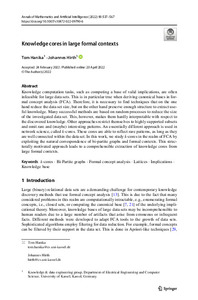| dc.date.accessioned | 2022-09-01T09:18:25Z | |
| dc.date.available | 2022-09-01T09:18:25Z | |
| dc.date.issued | 2022-04-20 | |
| dc.identifier | doi:10.17170/kobra-202206246401 | |
| dc.identifier.uri | http://hdl.handle.net/123456789/14121 | |
| dc.description.sponsorship | Gefördert im Rahmen des Projekts DEAL | ger |
| dc.language.iso | eng | eng |
| dc.rights | Namensnennung 4.0 International | * |
| dc.rights.uri | http://creativecommons.org/licenses/by/4.0/ | * |
| dc.subject | k-cores | eng |
| dc.subject | Bi-partite graphs | eng |
| dc.subject | formal concept analysis | eng |
| dc.subject | lattices | eng |
| dc.subject | implications | eng |
| dc.subject | knowledge base | eng |
| dc.subject.ddc | 004 | |
| dc.title | Knowledge cores in large formal contexts | eng |
| dc.type | Aufsatz | |
| dcterms.abstract | Knowledge computation tasks, such as computing a base of valid implications, are often infeasible for large data sets. This is in particular true when deriving canonical bases in formal concept analysis (FCA). Therefore, it is necessary to find techniques that on the one hand reduce the data set size, but on the other hand preserve enough structure to extract useful knowledge. Many successful methods are based on random processes to reduce the size of the investigated data set. This, however, makes them hardly interpretable with respect to the discovered knowledge. Other approaches restrict themselves to highly supported subsets and omit rare and (maybe) interesting patterns. An essentially different approach is used in network science, called k-cores. These cores are able to reflect rare patterns, as long as they are well connected within the data set. In this work, we study k-cores in the realm of FCA by exploiting the natural correspondence of bi-partite graphs and formal contexts. This structurally motivated approach leads to a comprehensible extraction of knowledge cores from large formal contexts. | eng |
| dcterms.accessRights | open access | |
| dcterms.creator | Hanika, Tom | |
| dcterms.creator | Hirth, Johannes | |
| dc.relation.doi | doi:10.1007/s10472-022-09790-6 | |
| dc.subject.swd | Wissensmanagement | ger |
| dc.subject.swd | Wissensbasis | ger |
| dc.subject.swd | Formale Begriffsanalyse | ger |
| dc.subject.swd | Verband <Mathematik> | ger |
| dc.type.version | publishedVersion | |
| dcterms.source.identifier | eissn:1573-7470 | |
| dcterms.source.issue | Issue 6 | |
| dcterms.source.journal | Annals of Mathematics and Artificial Intelligence | eng |
| dcterms.source.pageinfo | 537-567 | |
| dcterms.source.volume | Volume 90 | |
| kup.iskup | false | |


